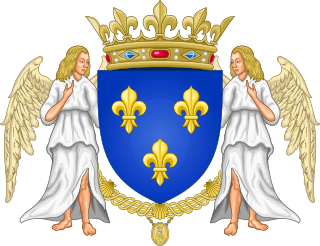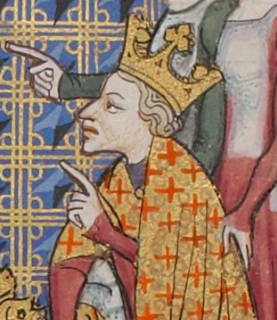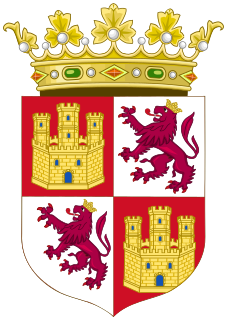
John of Gaunt, 1st Duke of Lancaster was an English royal prince, military leader, and statesman. A younger son of King Edward III of England, Gaunt was the father of King Henry IV. Due to Gaunt’s royal origin, advantageous marriages, and some generous land grants, he was one of the richest men of his era, and was an influential figure during the reigns of both his father, Edward, and his nephew, Richard II. As Duke of Lancaster, he is the founder of the royal House of Lancaster, whose members would ascend the throne after his death. His birthplace, Ghent, corrupted into English as Gaunt, was the origin for his name. When he became unpopular later in life, a scurrilous rumour circulated, along with lampoons, claiming that he was actually the son of a Ghent butcher. This rumour, which infuriated him, may have been inspired by the fact that Edward III had not been present at his birth.

The Capetian house of Valois was a cadet branch of the Capetian dynasty. They succeeded the House of Capet to the French throne, and were the royal house of France from 1328 to 1589. Junior members of the family founded cadet branches in Orléans, Anjou, Burgundy, and Alençon.

Charles II, called Charles the Bad, was King of Navarre 1349–1387 and Count of Évreux 1343–1387.

Charles V, called the Wise, was King of France from 1364 to his death in 1380. His reign marked an early high point for France during the Hundred Years' War, with his armies recovering much of the territory held by the English, and successfully reversed the military losses of his predecessors.

Ferdinand I, sometimes called the Handsome or occasionally the Inconstant, was the King of Portugal from 1367 until his death in 1383. His death led to the 1383–85 crisis, also known as the Portuguese interregnum.

Prince or Princess of Asturias is the main substantive title used by the heir apparent or heir presumptive to the throne of Spain. According to the Spanish Constitution of 1978:
Article 57 [...] 2. The heir apparent or presumptive, from birth or event that makes him such, will have the dignity of Prince of Asturias and other titles traditionally linked to the successor of the Crown of Spain.

Charles III, called the Noble, was King of Navarre from 1387 to his death and Count of Évreux from 1387 to 1404, when he exchanged it for the title Duke of Nemours. He spent his reign improving the infrastructure of his kingdom, restoring Navarre's pride after the dismal reign of his father, Charles the Bad, and mending strained relations with France.

Joanna la Beltraneja was a claimant to the throne of Castile, and Queen of Portugal as the wife of King Afonso V, her uncle.

Henry IV of Castile, King of Castile and León, nicknamed the Impotent, was the last of the weak late-medieval kings of Castile and León. During Henry's reign, the nobles became more powerful and the nation became less centralised.

Germaine of Foix was the queen consort of King Ferdinand II of Aragon from their marriage in 1506 until his death in 1516. His first wife, Isabella I of Castile, died in 1504.

The Battle of Nájera, also known as the Battle of Navarrete, was fought on 3 April 1367 near Nájera, in the province of La Rioja, Castile. It was an episode of the first Castilian Civil War which confronted King Peter of Castile with his half-brother Count Henry of Trastámara who aspired to the throne; the war involved Castile in the Hundred Years' War. Castilian naval power, far superior to that of France or England, encouraged the two polities to take sides in the civil war, to gain control over the Castilian fleet.

The Battle of Montiel was a battle fought on 14 March 1369 between the Franco-Castilian forces supporting Henry of Trastámara and the Granadian-Castilian forces supporting the reigning Peter of Castile.

The House of Trastámara was a royal dynasty which first ruled in the Crown of Castile and then expanded to the Crown of Aragon in the late middle ages to the early middle period.

The Crown of Castile was a medieval polity in the Iberian Peninsula that formed in 1230 as a result of the third and definitive union of the crowns and, some decades later, the parliaments of the kingdoms of Castile and León upon the accession of the then Castilian king, Ferdinand III, to the vacant Leonese throne. It continued to exist as a separate entity after the personal union in 1469 of the crowns of Castile and Aragon with the marriage of the Catholic Monarchs up to the promulgation of the Nueva Planta decrees by Philip V in 1715.

The Caroline War was the second phase of the Hundred Years' War between France and England, following the Edwardian War. It was so-named after Charles V of France, who resumed the war nine years after the Treaty of Brétigny. The Kingdom of France dominated this phase of the war.

The Castilian Civil War was a war of succession over the Crown of Castile that lasted from 1351 to 1369. The conflict started after the death of king Alfonso XI of Castile in March 1350. It became part of the larger conflict then raging between the Kingdom of England and the Kingdom of France: the Hundred Years' War. It was fought primarily in Castile and its coastal waters between the local and allied forces of the reigning king, Peter, and his illegitimate brother Henry of Trastámara over the right to the crown.
The War of the Two Peters was fought from 1356 to 1375 between the kingdoms of Castile and Aragon. Its name refers to the rulers of the countries, Peter of Castile and Peter IV of Aragon. One historian has written that "all of the centuries-old lessons of border fighting were used as two evenly matched opponents dueled across frontiers that could change hands with lightning speed."
Events from the 1360s in England.

Ferdinand II, also called Ferdinand the Catholic, was King of Aragon and Sardinia from 1479, King of Sicily from 1469, King of Naples from 1504 and King of Navarre from 1512 until his death in 1516. He was King of Castile and León from 1475 to 1504, alongside his wife Queen Isabella I. From 1507 to 1516, he was the Regent of the Crown of Castile, making him the effective ruler of Castile. From 1511 to 1516, he styled himself as Imperator totius Africa after having conquered Tlemcen and making the Zayyanid Sultan, Abu Abdallah V, his vassal. He was also the Grandmaster of the Spanish Military Orders of Santiago (1499-1516), Calatrava (1487-1516), Alcantara (1492-1516) and Montesa (1499-1516), after he permanently annexed them into the Spanish Crown. He reigned jointly with Isabella over a dynastically unified Spain; together they are known as the Catholic Monarchs. Ferdinand is considered the de facto first King of Spain, and was described as such during his reign despite the Crown of Aragon and Castile being two distinct entities until the Crown of Aragon was partitioned, sold off and absorbed into Castile via the absolutist Nueva Planta decrees issued by the Spanish Bourbons inbetween 1707 and 1716, following the War of the Spanish Succession.

The Spanish conquest of the Iberian part of Navarre was initiated by Ferdinand II of Aragon and completed by his grandson and successor Charles V in a series of military campaigns lasting from 1512 to 1524. Ferdinand was both the king of Aragon and regent of Castile in 1512. When Pope Julius II declared a Holy League against France in late 1511, Navarre attempted to remain neutral. Ferdinand used this as an excuse to attack Navarre, conquering it while its potential protector, France, was beset by England, Venice, and Ferdinand's own Italian armies.
















